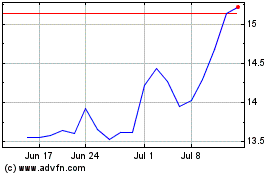Banks Enlist Congress on Loan Rule -- WSJ
October 18 2018 - 3:02AM
Dow Jones News
By Michael Rapoport
This article is being republished as part of our daily
reproduction of WSJ.com articles that also appeared in the U.S.
print edition of The Wall Street Journal (October 18, 2018).
Some banks are fighting a rearguard action to blunt the impact
of a new accounting rule that revamps how they book losses on
soured loans, and members of Congress are siding with the banks in
their dispute with independent rule makers.
The rule, which takes effect starting in 2020, will require
banks to record all future losses they expect on loans as soon as
they are made. Banks argue the regulation will have dire
consequences when the next economic downturn comes, saying the rule
could reduce their ability to lend during a future recession.
Officials from Regions Financial Corp., BB&T Corp., Citizens
Financial Group Inc., KeyCorp and M&T Bank Corp. met last month
in Washington with regulators, congressmen and accounting rule
makers to press their case, in a meeting that hasn't previously
received wide attention. They expect to formally propose changes in
the new rule soon to the Financial Accounting Standards Board, like
a modification that would reduce the rule's impact on their
earnings. The FASB says it will consider the banks' proposals.
"The banks I talk to are still livid about this," Rep. Blaine
Luetkemeyer (R., Mo.), a House Financial Services Committee
subcommittee chairman who hosted the meeting, said in an interview.
He said a "legislative fix" might be needed, though it is unusual
for Congress to intervene in how accounting rules are set.
Daryl Bible, BB&T's chief financial officer, said on a July
conference call that the rule was "a huge risk to the country, to
the economy, and people really need to think about it."
Advocates believe the change will give investors more timely
information about banks' true financial condition. "What we're
doing is giving investors a far better starting point for
understanding management's expectations of losses," said Hal
Schroeder, a member of the FASB, which sets accounting rules for
U.S. companies.
The rule, which the FASB issued in 2016, represents a
fundamental shift in how banks treat loan losses. Currently, they
don't record losses until they have evidence the losses will
actually occur. Supporters of the change say that approach led
banks to record losses too slowly after the 2008 financial crisis,
leaving investors in the dark.
The new, upfront method -- known as "CECL," short for "current
expected credit losses" and pronounced "Cecil" -- is intended to
make banks more transparent. But the new method also could require
some banks to significantly boost their loan-loss reserves, which
could cut into their earnings and regulatory capital.
Some banks say the rule will make them less able to make loans,
which in a recession could make bad economic conditions worse.
That's because a bad economy would further boost projections for
future loan losses, they say, causing the banks to further increase
reserves and leaving them with less capital to lend.
But Mr. Schroeder said studies have shown that banks that added
to reserves earlier either continued to lend during downturns or
didn't reduce lending by as much as others.
Banks have complained about the rule before, and regulators
already have proposed moves to help banks cope with its effects.
For example, regulators proposed allowing banks to phase in the
capital impact of the new rule over three years, though some banks
think the impact should be softened even further.
Some banks also have pushed for a proposal where they would
still set aside reserves for all expected future losses, but only
the reserves for near-term losses would hit their earnings and
regulatory capital.
Even as some banks try to water down the rule, they are gearing
up to adopt it as it stands now. Banks are gathering data and
designing and building internal systems to prepare. Most banks
haven't yet indicated how much they may have to boost their loss
reserves as a result of the rule.
Write to Michael Rapoport at Michael.Rapoport@wsj.com
(END) Dow Jones Newswires
October 18, 2018 02:47 ET (06:47 GMT)
Copyright (c) 2018 Dow Jones & Company, Inc.
KeyCorp (NYSE:KEY)
Historical Stock Chart
From Mar 2024 to Apr 2024

KeyCorp (NYSE:KEY)
Historical Stock Chart
From Apr 2023 to Apr 2024
